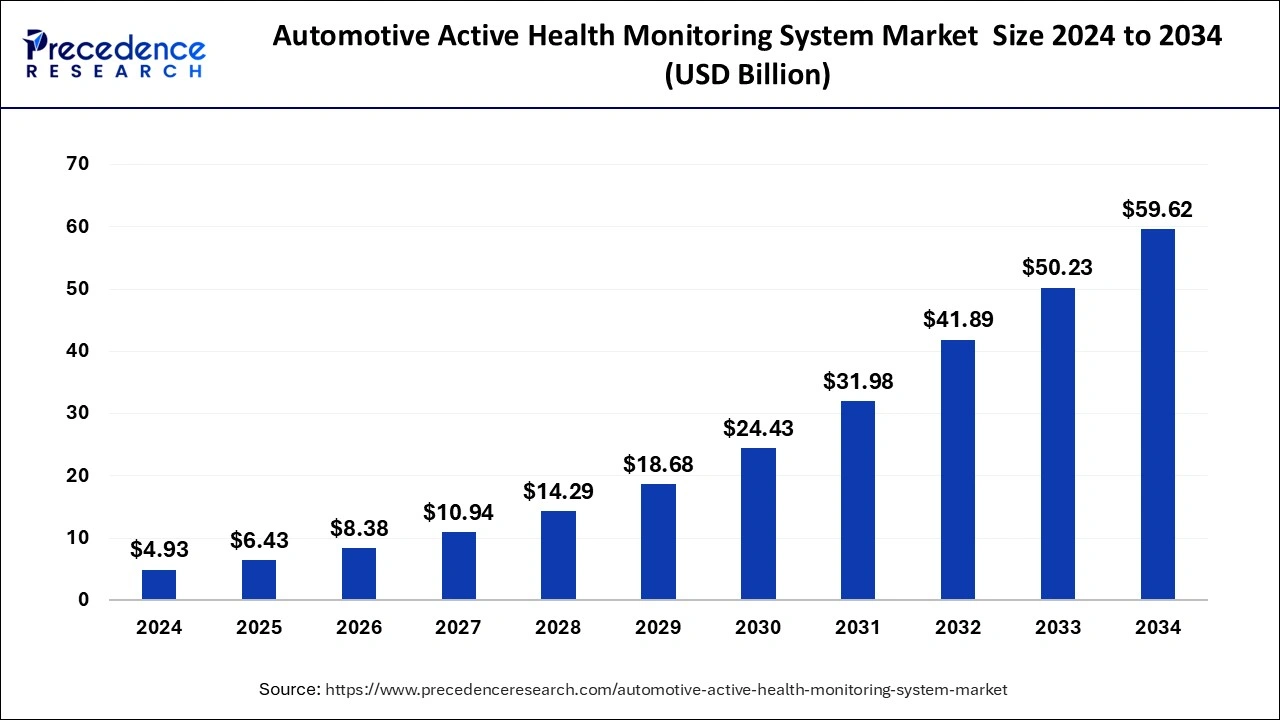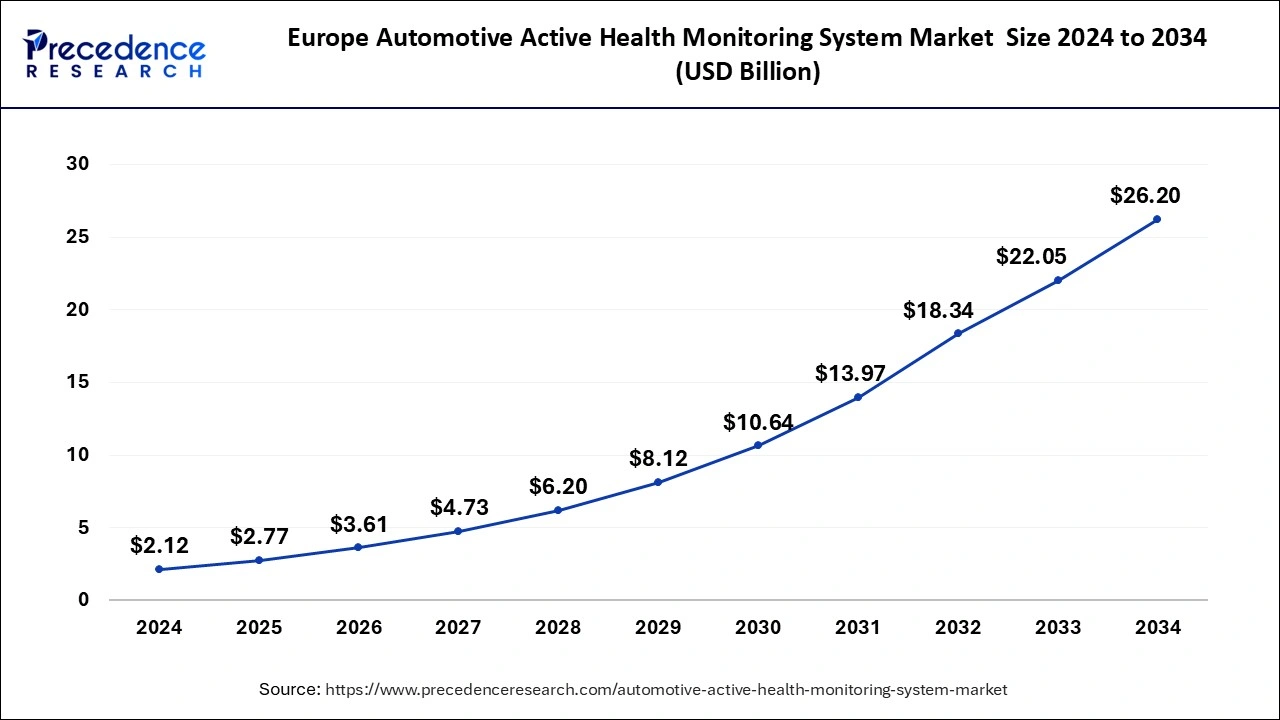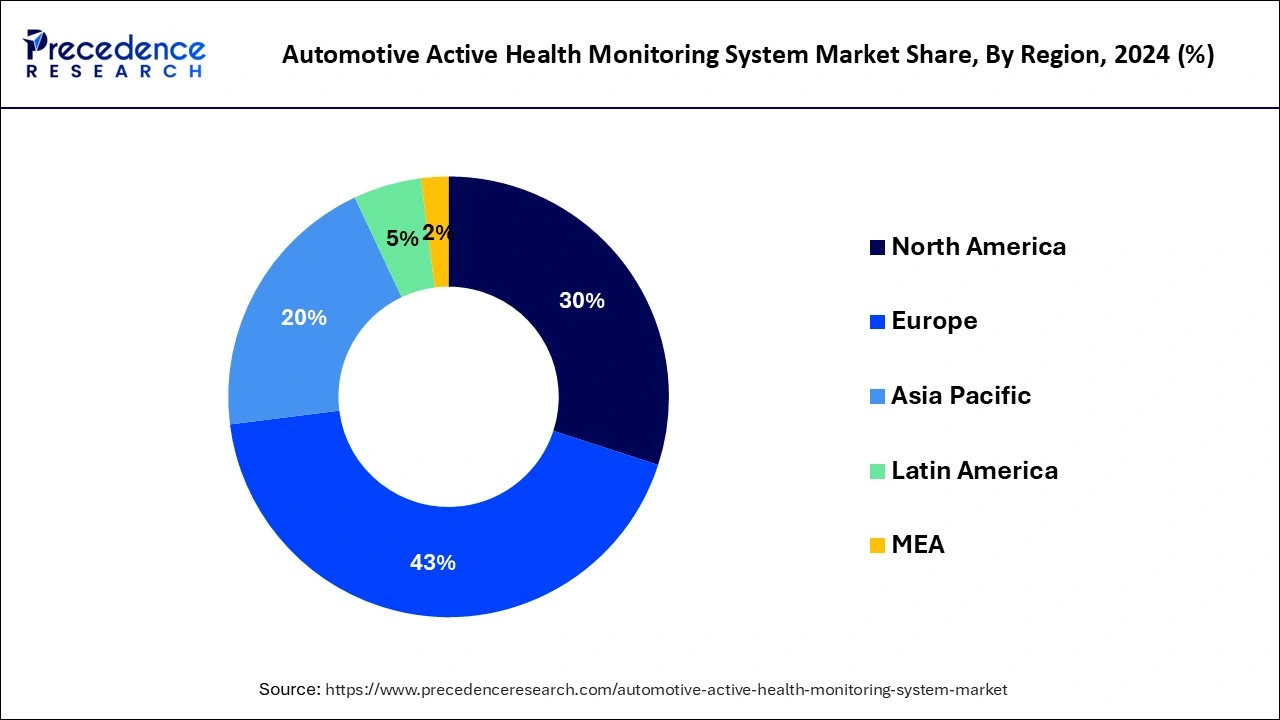List of Contents
Automotive Active Health Monitoring System Market Size and Forecast 2025 to 2034
The global automotive active health monitoring system market size was valued at USD 4.93 billion in 2024 and is expected to reach USD 59.62 billion by 2034, with a CAGR of 28.3% from 2025 to 2034.

Key Takeaways
- Europe led the global market with the highest market share of 43% in 2024.
- Asia Pacific is projected to expand at the fastest CAGR during the forecast period.
- By Location, the dashboard segment has held the largest market share in 2024.
- By Location, the car seat segment is expected to grow at a remarkable CAGR during the forecast period.
- By Application, the pulse segment is estimated to hold the highest market share in 2024.
Automotive Active Health Monitoring System Market in Europe 2025 to 2034
The Europe automotive active health monitoring system market size was exhibited at USD 2.12 billion in 2024 and is projected to surpass USD 26.20 billion by 2034, growing at a CAGR of 28.58% from 2025 to 2034.

Europe is the front-runner in the global automotive active health monitoring system market and is estimated to continue its dominance in the upcoming years. This is mainly because of the presence of several automotive giants in the region and is largely focused on incorporating driver assistance systems and other safety features in the vehicle. These automotive players are also extensively focused on Research & Development (R&D) for improving the in-vehicle health monitoring system.
On the contrary, the Asia Pacific exhibits the fastest growth over the forecast period owing to the rapid adoption of advanced electronics components in the automotive industry. In addition, rapid growth in the demand for advanced safety features in the vehicle owing to the increasing number of accidents also trigger the demand for active health monitoring systems in the region. To ensure driver safety, the government has also mandated the integration of health monitoring technologies in the upcoming automobiles to reduce the loss of life and property caused because of road accidents.

Automotive Active Health Monitoring System Market Growth Factors
The automotive industry has been upended in the recent past because of the increasing integration of advanced technologies such as Artificial Intelligence (AI), vehicle automation, and the Internet of Things (IoT). Within the industry, an array of institutions that include public agencies, universities, and major market players are working in tandem to explore the potential benefits of such technologies in the automobile industry. In the recent past, active health monitoring system in the automotive industry has gained prominent popularity, and the same trend is expected to continue in the forthcoming years.
Favorable government policies related to passenger safety have compelled the market players to integrate health monitoring technologies in the automotive sector. In the wake of the same, many healthcare organizations and automotive giants are collaborating with each other for improving passenger safety in the vehicle. Presently, seat belts and steering wheels can provide real-time data related to the driver's health. Though the technology is at its budding phase, pairing wearable technology with automotive active health monitoring systems is a trend that likely to gain notable traction in the upcoming years. Further, advancements in the microelectronics and electronics fields have given rise to cost-effective devices that are significantly applied in various monitoring tools.
Market Scope
| Report Highlights | Details |
| Market Size in 2025 | USD 6.43 Billion |
| Market Size by 2034 | USD 59.62 Billion |
| Market Growth Rate from 2025 to 2034 | CAGR of 28.3% |
| Largest Market | Europe |
| Base Year | 2024 |
| Forecast Period | 2025 to 2034 |
| Segments Covered | Location, Component, Vehicle Type, Deployment, Application, and Region |
| Regions Covered | North America, Europe, Asia-Pacific, Latin America and Middle East & Africa |
Location Insights
The dashboard is anticipated to be the highly attractive segment within the global automotive active health monitoring market. This is mainly attributed to the incorporation of AI and machine learning for face detection, gesture recognition, tiredness, and distraction of drivers to prevent accidents. With these advanced technologies mood and other emotions of the driver is being detected which helps the automated car technology to switch the driving mode into the safe mode if the driver is not in a healthy driving condition.
Apart from this, the car seat is another important segment that is likely to capture a prominent value share in the overall market. The rising trend of health monitoring wearable technologies on the driver's seat for continuously monitoring the pulse, blood pressure, and sugar level of the driver is another prominent trend that boosts the adoption of active health monitoring systems in the car seat segment.
Application Insights
The pulse application segment leads the global automotive active health monitoring system market in the year 2023. The significant growth of the segment is mainly because the variation in the pulse of the driver is the major cause of an accident. Variation in the heartbeat reflects the irregular blood flow in the lungs and other parts of the body that may lead to cardiac arrest or other serious problems and this may cause a road accident. To prevent this, pulse monitoring devices are incorporated in the driver's seat that continuously monitors and reflects the real-time data of the heart functioning. Any irregularity in the pulse raises an alarm and the system alerts the driver to discontinue driving. This could prevent from several road accidents along with injury & loss of life. The aforementioned factors are the major contributors to the significant growth of the pulse segment.
Automotive Active Health Monitoring System Market Companies
- Faurecia
- TATA Elxsi
- Plessey Semiconductors
- Acellent Technologies
- Hoana Medical, Inc.
- LORD
- Micro Strain Sensing Systems
- FLEX LTD.
Segments Covered in the Report
By Location
- Dashboard
- Car Seat
By Component
- Sensors
- Others
By Vehicle Type
- Commercial Vehicle
- Passenger Vehicle
By Deployment
- Cloud-based
- On-premise
By Application
- Pulse
- Blood Pressure
- Blood Sugar Level
- Others
By Geography
- North America
- Europe
- Asia Pacific
- Latin America
- Middle East and Africa
For inquiries regarding discounts, bulk purchases, or customization requests, please contact us at sales@precedenceresearch.com
Frequently Asked Questions
Ask For Sample
No cookie-cutter, only authentic analysis – take the 1st step to become a Precedence Research client